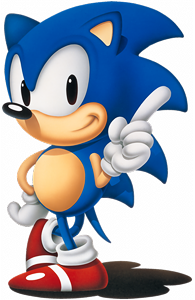Bugs Bunny is a perfect examples of pulling these techniques off. He still looks like a rabbit while having exaggerated human features.
 Klonoa is suppose to be his own breed of animal but as you can see he has cat-like features mixed with human elements. The standard things are exaggerated and elongated (legs, arms, hands, feet) but his ears are also long. These ears not only create a unique animation but also add to the gameplay.
Klonoa is suppose to be his own breed of animal but as you can see he has cat-like features mixed with human elements. The standard things are exaggerated and elongated (legs, arms, hands, feet) but his ears are also long. These ears not only create a unique animation but also add to the gameplay. I can't write about animal characters without mentioning Sonic the Hedgehog. You can read more about him here.
I can't write about animal characters without mentioning Sonic the Hedgehog. You can read more about him here.
Humans

Astro boy is one of the older Japanese characters. Notice the big eyes and exaggerated emotion. These are all traits the Japanese learned from watching Disney.
You will notice that most stylized humans in games feature big eyes. These big eyes help with expressing emotion (just like with animal characters). Also these characters usually have enlarged heads. The face is the most important thing for the player to read their character (especially in older games where the hero rarely spoke) and when you have a big head you can exaggerate the face.
 Super Mario is easily the most recognizable figure in video games. He is such a great character not only because of his early design but also for his later more polished design. Once Nintendo had the technology they made Mario more cartoon-like. His features could fit into any Disney movie.
Super Mario is easily the most recognizable figure in video games. He is such a great character not only because of his early design but also for his later more polished design. Once Nintendo had the technology they made Mario more cartoon-like. His features could fit into any Disney movie. Link from The Windwaker. Rather than going with the realistic look, The Windwaker took Zelda into a cartoony animation style. It was a blend of modern Anime and Disney. Some features (such as the eyes and certain character emotions) came from anime, while the colours and enemy models look like they are straight out of a Disney movie. This cel-shading style (the use of 2D art on 3D character) has become extremely popular.
Link from The Windwaker. Rather than going with the realistic look, The Windwaker took Zelda into a cartoony animation style. It was a blend of modern Anime and Disney. Some features (such as the eyes and certain character emotions) came from anime, while the colours and enemy models look like they are straight out of a Disney movie. This cel-shading style (the use of 2D art on 3D character) has become extremely popular. A typical Tex Avery character emotion. Even though the character is very distorted it is still recognizable and easy to read.
A typical Tex Avery character emotion. Even though the character is very distorted it is still recognizable and easy to read. Dhalsim was one of the more unique fighters in Street Fighter 2. What made him so strange was his ability to stretch and contort his body. The rubber qualities of Dhalsim are very similiar to a Tex Avery cartoon in which the characters were always stretched in every which way. This picture is from the newest revision of Street Fighter 2.
Dhalsim was one of the more unique fighters in Street Fighter 2. What made him so strange was his ability to stretch and contort his body. The rubber qualities of Dhalsim are very similiar to a Tex Avery cartoon in which the characters were always stretched in every which way. This picture is from the newest revision of Street Fighter 2.The Nintendo character most influenced by Tex Avery is Kirby. Kirby may take a lot of cues from anime in his design, but the gameplay is all Tex Avery. Kirby stretches and contorts his body as he eats his enemies or flies through the sky. He can change his form into a completely different physical shape and structure to attack with special powers. If Tex Avery was designing video games you can bet he would create a character like Kirby.
Because of the early cartoon like nature of video games it was only natural for designers to take some cues from animation. Furthermore, videogames started off as a children's market so it was only natural to tie it to another thing that children liked. Animation helped give designers the tools they needed in order to make a memorable and appealing game.
No comments:
Post a Comment